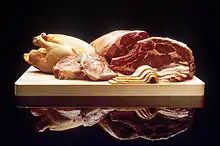Partridge
Partridges are medium-sized non-migratory birds, with a wide native distribution throughout Europe, Asia, and parts of Africa. They are sometimes grouped in the Perdicinae subfamily of the Phasianidae (pheasants, quail, etc.). However, molecular research suggests that partridges are not a distinct taxon within the family Phasianidae, but that some species are closer to the pheasants, while others are closer to the junglefowl.[1]


| Partridge | |
|---|---|
.jpg.webp) | |
| Crested wood partridge (Rollulus rouloul) | |
| Scientific classification | |
| Kingdom: | |
| Phylum: | |
| Class: | |
| Order: | |
| Family: | Horsfield, 1821 |
| Subfamily: | Horsfield, 1821 |
| Genus | |
|
Alectoris | |
Description
These are medium-sized birds, intermediate between the larger pheasants and the smaller quail.
Range and habitat
Partridges are native to Europe, Asia, Africa and the Middle East. Some species are found nesting on steppes or agricultural land, while others species prefer more forested areas. They nest on the ground and have a diet consisting of seeds, grapes and insects.
Hunting
Species such as the grey partridge and the red-legged partridge are popular as game birds, and are often reared in captivity and released for the purpose of hunting. For the same reason, they have been introduced into large areas of North America.
Cultural references
According to Greek legend, the first partridge appeared when Daedalus threw his nephew, Perdix, off the sacred hill of Athena in a fit of jealous rage. Supposedly mindful of his fall, the bird does not build its nest in the trees, nor take lofty flights and avoids high places.[2]
In the Bible it is stated: "As the partridge sitteth on eggs, and hatcheth them not; so he that getteth riches, and not by right, shall leave them in the midst of his days, and at his end shall be a fool." (Jeremiah 17 : 11, King James Bible).
Probably the most famous reference to the partridge is in the Christmas carol, "The Twelve Days of Christmas".[3] The first gift listed is "a partridge in a pear tree", and these words end each verse. Since partridges are unlikely to be seen in pear-trees (they are ground-nesting birds) it has been suggested that the text "a pear tree" is a corruption of the French "une perdrix".
The partridge has also been used as a symbol that represents Kurdish nationalism. It is called Kew. Sherko Kurmanj discusses the paradox of symbols in Iraq as an attempt to make a distinction between the Kurds and the Arabs. He says that while Iraqis generally regards the palm tree, falcon, and sword as their national symbols, the Kurds consider the oak, partridge, and dagger as theirs.[4]
Species list in taxonomic order
- Genus Lerwa
- Snow partridge, Lerwa lerwa
- Genus Tetraophasis
- Verreaux's monal-partridge, Tetraophasis obscurus
- Szechenyi's monal-partridge, Tetraophasis szechenyii
- Genus Alectoris
- Arabian partridge, Alectoris melanocephala
- Przevalski's partridge, Alectoris magna
- Rock partridge, Alectoris graeca
- Chukar, Alectoris chukar
- Philby's partridge, Alectoris philbyi
- Barbary partridge, Alectoris barbara
- Red-legged partridge, Alectoris rufa
- Genus Ammoperdix
- See-see partridge, Ammoperdix griseogularis
- Sand partridge, Ammoperdix heyi
- Genus Perdix
- Grey partridge, Perdix perdix
- Daurian partridge, Perdix dauurica
- Tibetan partridge, Perdix hodgsoniae
- Genus Rhizothera
- Long-billed partridge, Rhizothera longirostris
- Hose's partridge، Rhizothera dulitensis
- Genus Margaroperdix
- Madagascar partridge, Margaroperdix madagascarensis
- Genus Melanoperdix
- Black wood-partridge, Melanoperdix nigra
- Genus Xenoperdix
- Rubeho forest partridge, Xenoperdix obscuratus
- Udzungwa forest partridge, Xenoperdix udzungwensis
- Genus Arborophila, the hill partridges
- Hill partridge, Arborophila torqueola
- Sichuan partridge, Arborophila rufipectus
- Chestnut-breasted partridge, Arborophila mandellii
- White-necklaced partridge, Arborophila gingica
- Rufous-throated partridge, Arborophila rufogularis
- White-cheeked partridge, Arborophila atrogularis
- Taiwan partridge, Arborophila crudigularis
- Hainan partridge, Arborophila ardens
- Chestnut-bellied partridge, Arborophila javanica
- Grey-breasted partridge, Arborophila orientalis
- Bar-backed partridge, Arborophila brunneopectus
- Orange-necked partridge, Arborophila davidi
- Chestnut-headed partridge, Arborophila cambodiana
- Red-breasted partridge, Arborophila hyperythra
- Red-billed partridge, Arborophila rubrirostris
- Scaly-breasted partridge, Arborophila chloropus
- Chestnut-necklaced partridge, Arborophila charltonii
- Sumatran partridge, Arborophila sumatrana
- Vietnam partridge, Arborophila merlini
- Genus Caloperdix
- Ferruginous partridge, Caloperdix oculea
- Genus Haematortyx
- Crimson-headed partridge, Haematortyx sanguiniceps
- Genus Rollulus
- Crested partridge, Rollulus roulroul
- Genus Bambusicola
- Mountain bamboo partridge, Bambusicola fytchii
- Chinese bamboo partridge, Bambusicola thoracica
See also
- Dick Potts, English ecologist and specialist in the partridge.
References
- Kimball, R. T.; Braun, E. L.; Zwartjes, P. W.; Crowe, T. M.; Ligon, J. D. (1999). "Molecular phylogenetics and evolution: A molecular phylogeny of the pheasants and partridges". Molecular Phylogenetics and Evolution. 11 (1): 38–54. doi:10.1006/mpev.1998.0562. PMID 10082609.
- Holmes, Richard (2013). Falling Upwards: How We Took to the Air. HarperCollins. p. 1760. ISBN 9780007467259. Retrieved 16 April 2013.
- The Associated Press (November 26, 2012). "'12 days of Christmas' cost: How much is a partridge in a pear tree?". The Christian Science Monitor. Retrieved 8 May 2014.
- Kurmanj, Sherko (2014). "The Roots of Modern Kurdish Nationalism". In Bengio, Ofra (ed.). Kurdish Awakening: Nation Building in a Fragmented Homeland. University of Texas Press. p. 96. ISBN 978-0-292-75813-1.
External links
| Look up partridge in Wiktionary, the free dictionary. |
| Wikimedia Commons has media related to Phasianidae. |
- Videos, photos and sounds - Internet Bird Collection






